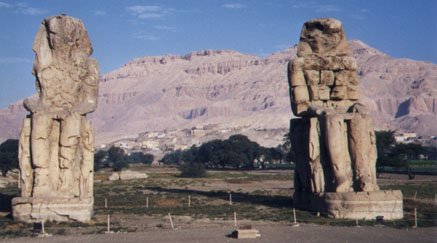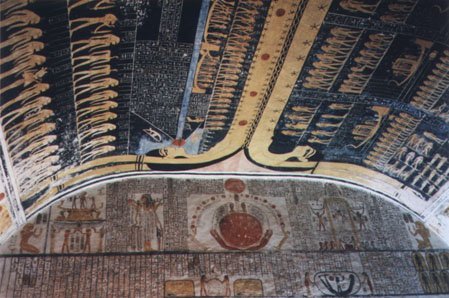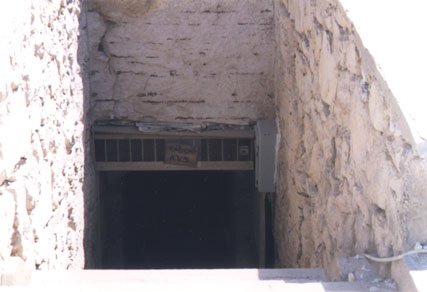VALLEY OF
THE KINGS (THEBES)

Our first stop on this day was at the Colossi of Memnon. These huge (18 meters
high, 1,300 tons each) seated statues appear to be sitting out in the middle of a
floodplain, next to a road. One might wonder what they are doing out there by themselves,
with no recognizable ruins nearby. However, these statues were actually the gate guardians
for the large 14th century B.C. mortuary temple of Amenophis III (Amenhotep), which was
destroyed by an earthquake in 27 B.C. The ruined temple has since disappeared
(thanks to the flooding of the Nile and some of the stones being taken for other
purposes), but the damaged statues continue their lonely vigil. See the illustration below
to get an idea of what the statues looked like in front of the temple, circa three
thousand years ago.
According to the history of the region, when the sun rose the
Colossi used to "sing" (or cry, depending on your source). This was probably due
to wind moving through the fractures, and vibrations of sand particles within the cracks,
as the statues heated up and the fractures expanded under the sun's heat. The Greek
historian Strabo reported the phenomenon, helping to spread the story that the statues
were wailing for dead loved ones. The site became a destination for pilgrimages, including
at least two Roman emperors. One of the emperors decided to gain favor with the gods by
repairing the already crumbling statues, but after the restoration was completed the
statues spoke no more.
After going from the colossi to Medinet Habu, we proceeded to the Valley
of the Queens. There are about eighty tombs there (though only a few are open to the
public), but most tourists tend to concentrate on the adjacent Valley of the Kings. There
is one tomb in the Valley of the Queens, though, that has become famous because of its
great beauty. It is the tomb of the famous queen Nefertari, and it is one of the more
complex tombs there. Restored in 1992 after a four year effort, access to the tomb is now
limited to only about one hundred people a day (a mere fraction of those who want to see
it). We were very happy that our guide was able to buy tickets for us on the black market
(the few tickets go on sale first thing in the morning, and sell out quickly). It was one
of the highlights of our trip, and well worth the $40 entrance fee. The photo above shows
a typical set of rooms in Nefertari's tomb, whose walls are decorated with scenes from the
ancient Egyptian Book of the Dead. On the right we see the goddess Hathor and the god
Ra-Harakhte, who is under the morning sun (he's the one with the head of a falcon). On the
left is a figure that we rarely saw depicted: the scarab-head deity called Khepri. The
ceiling is covered in five-pointed yellow stars on a field of blue, a sacred
representation that we saw in a number of places during our time in Egypt.
This is another photo from the booklet of Nefertari's tomb that
we bought at the site (our photos were not as nice, as flash photography is prohibited
inside the tombs). This is the staircase leading down to the burial chamber. Above left is
an large winged serpent protecting the cartouche of Nefertari, above a representation of
the god Anubis, shown as a jackal. On the right is the winged goddess Maat above the
doorway, with more of the blue sky and star pattern overhead.
Next we move on to the Valley of the Kings. This is a slightly overhead
view of one area in the valley, showing the walkways and tomb entrances. Not all of the
tombs are open, and most tour groups have a limited time to spend in the valley, so most
people only see a few tombs during their time here.
The one tomb that most people want to see is the tomb of
Tutankhamun ("King Tut"). Tutankhamun is probably the only pharoah whose body
still remains in his tomb (shown above encased in a gold sarcophagus in the burial
chamber). I say "probably", because it is still believed by some that there is
one or two more tombs in the valley that have yet to be discovered. Despite it's great
fame (due to the treasures that were found within), the tomb itself is not as impressive
as others belonging to more important pharoahs. In fact, our guide told us not to bother
with Tut's tomb, as the best parts (its contents) are in the Cairo Museum, not here.

Sometimes it's amazing what 800 speed film can do without a flash. I took this
picture inside the tomb of Ramesses VI, which was one of the better tombs that I saw.
Unfortunately this photo only shows a portion of the spectacular ceiling, which has dual
figures of the sky goddess Nut running down its middle. Her outstretched arms and legs
framed the junction of the wall to ceiling, and helped make this the most memorable tomb
painting that I encountered.

For me, though, the most fascinating tomb was the one that we
saw but never entered. This is the entrance to KV5 (Kings Valley, tomb #5). This tomb is
closed to the public, as it is still being explored. It was found in 1825, but abandoned
as uninteresting (it was filled almost to the ceiling with tightly packed earth and other
debris washed in during the centuries of occasional flooding in the valley). The location
of the entrance was then buried by nearby excavations, rendering the tomb lost again. It
was rediscovered in 1995 by archeologist Kent Weeks, who also discovered that the tomb was
far bigger than had been reported 170 years earlier. So much bigger, in fact, that they
still haven't found the end of it. Instead of the original six rooms, the current count is
over 110 chambers, making it the largest tomb in Egypt. Obviously this is not the tomb of
one man, but of many. It is believed to be the tomb of the fifty sons of Ramesses II (who
was not only long-lived, but very prolific). Anyway, the tomb's rediscovery has been the
biggest thing in Egyptian archeology since King Tut, and I was hooked after reading Week's
account in his book The Lost Tomb. If you're interested, check out the KV5 website, which has progress reports and
QuickTime videos of the layout of the tomb.